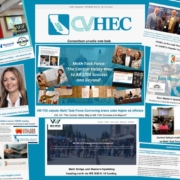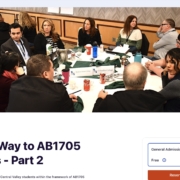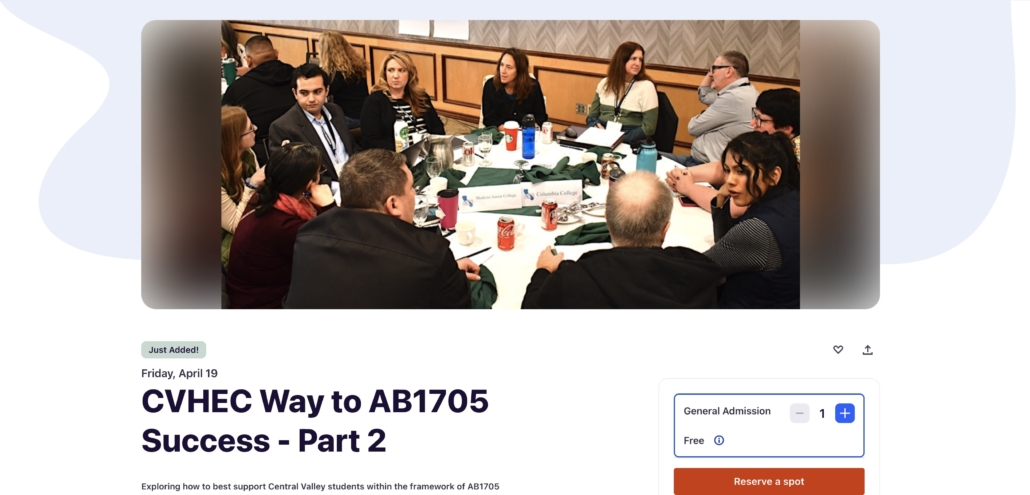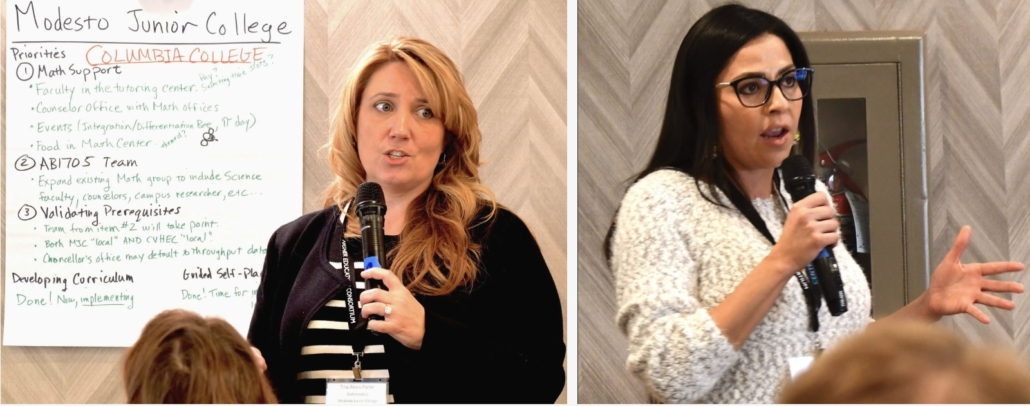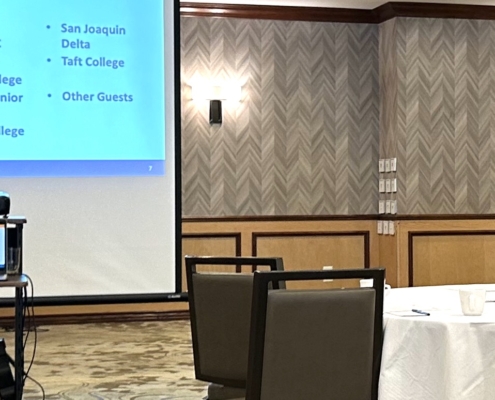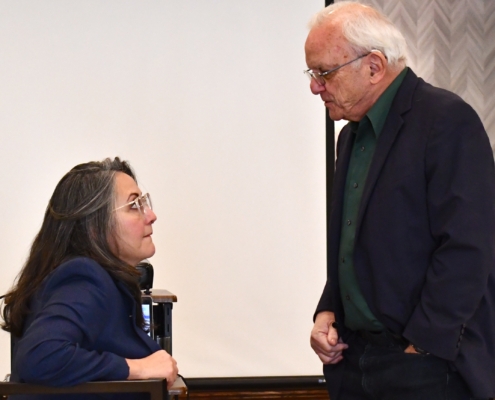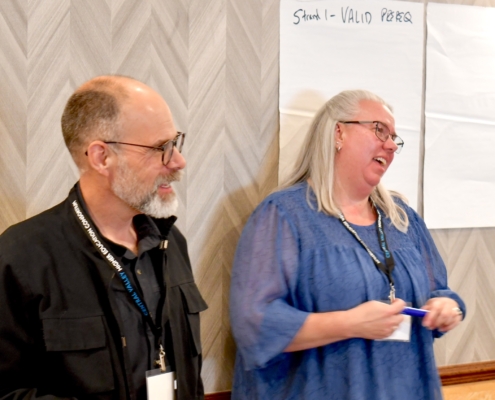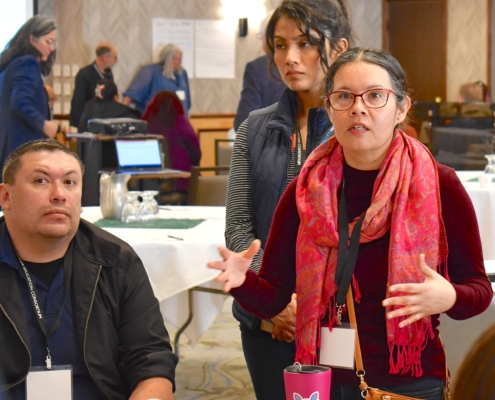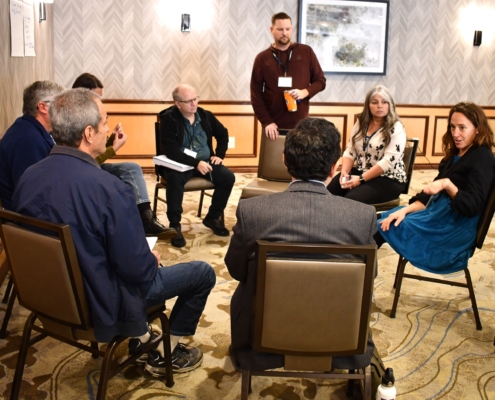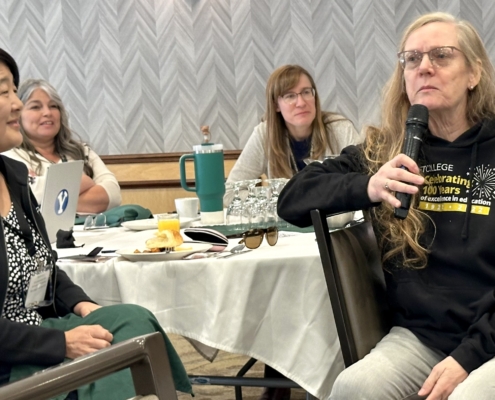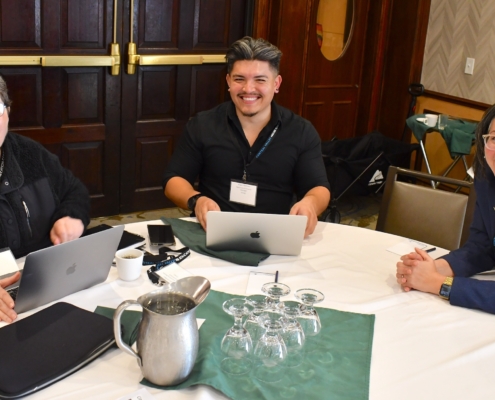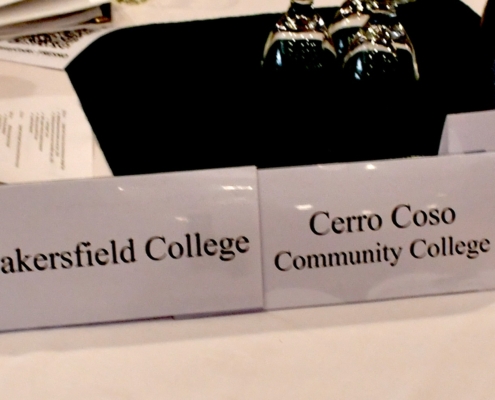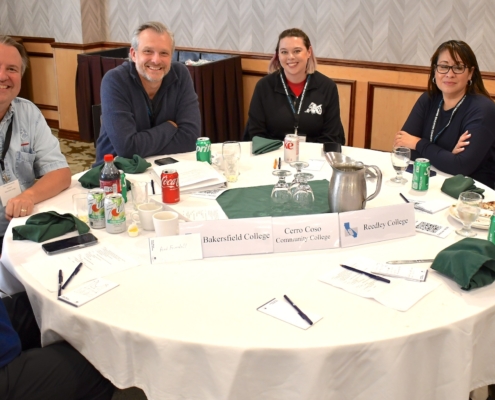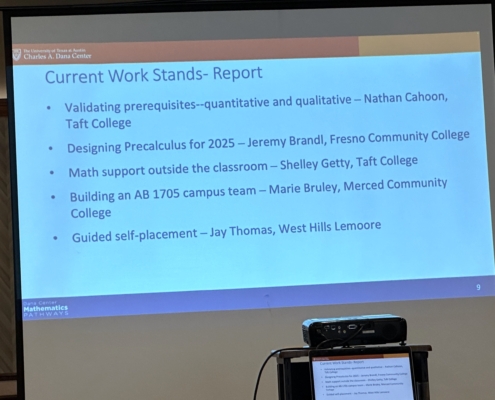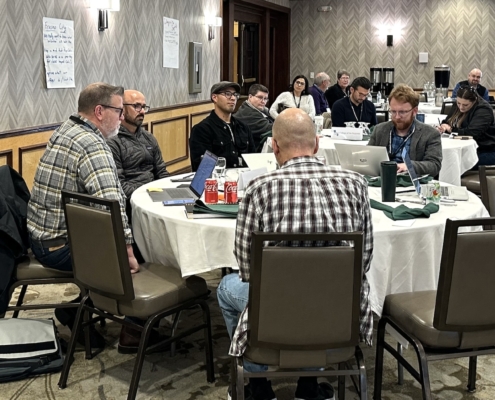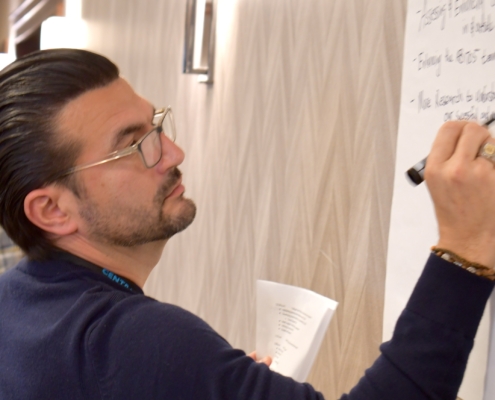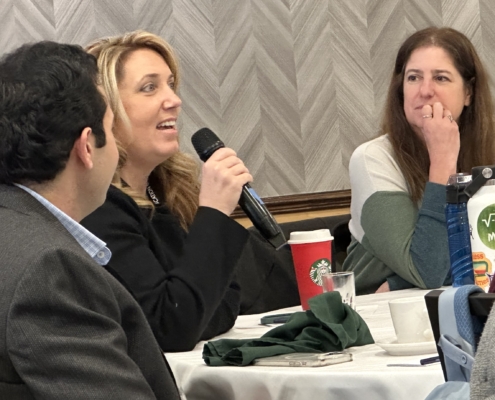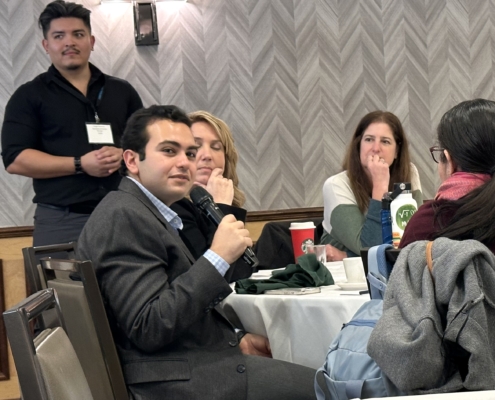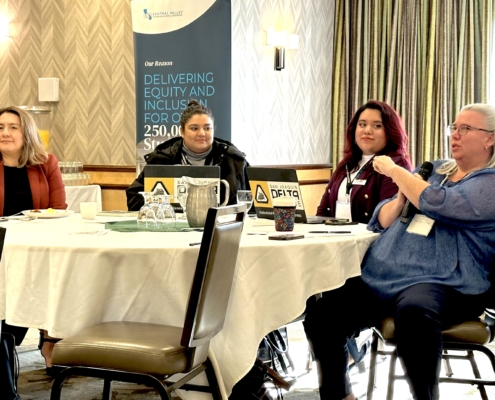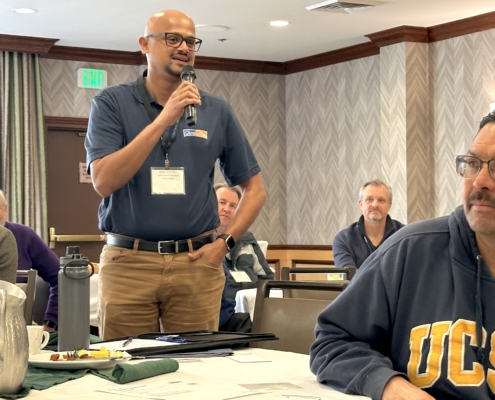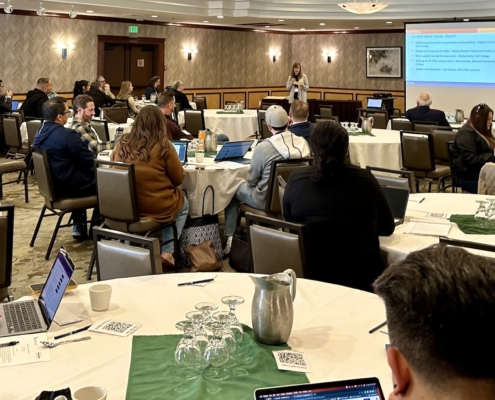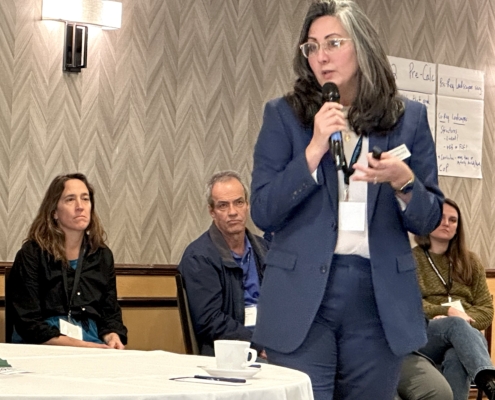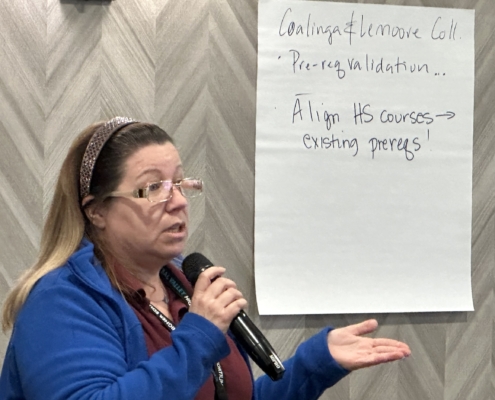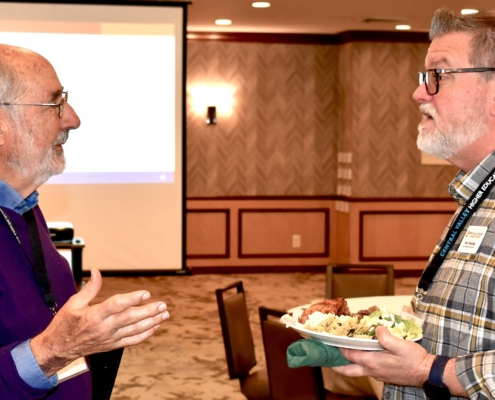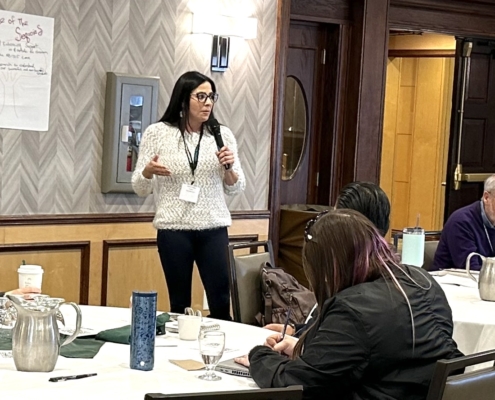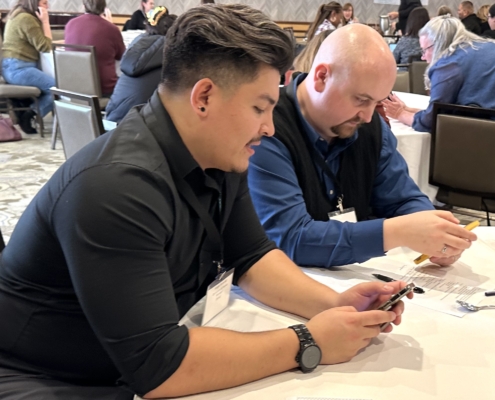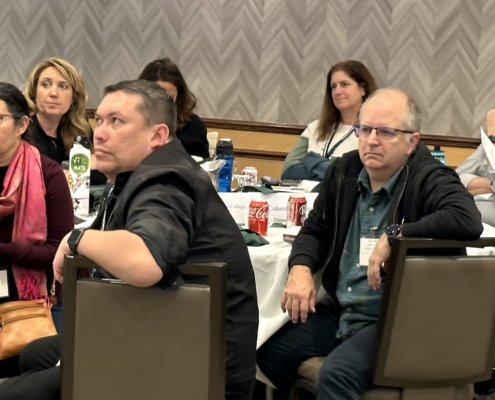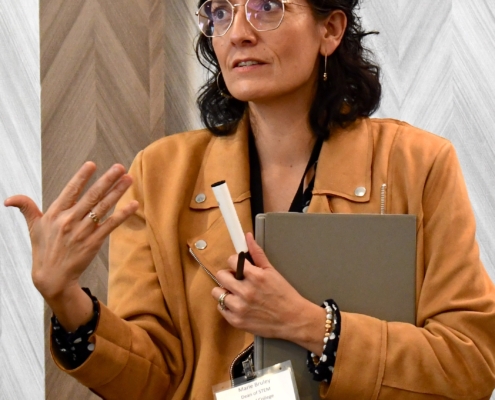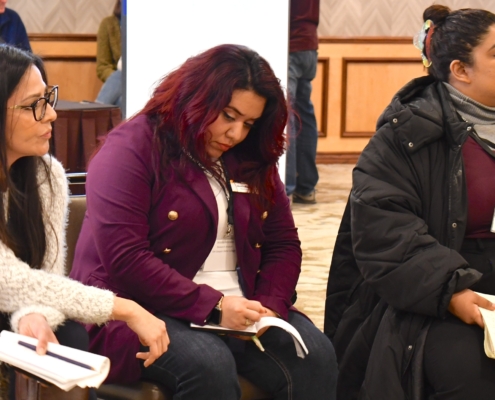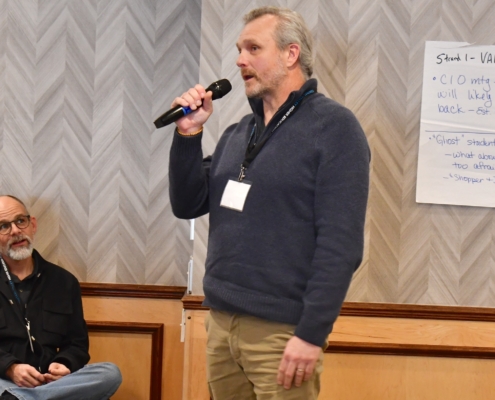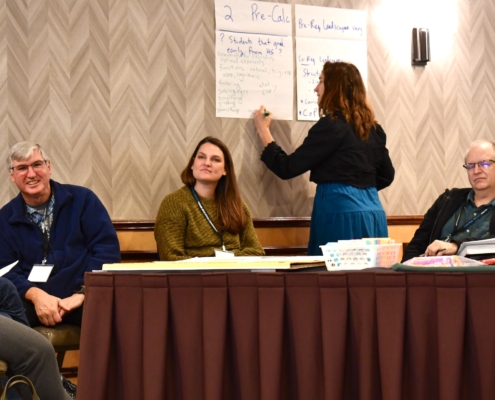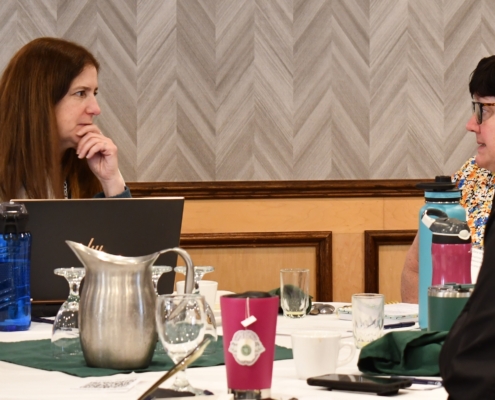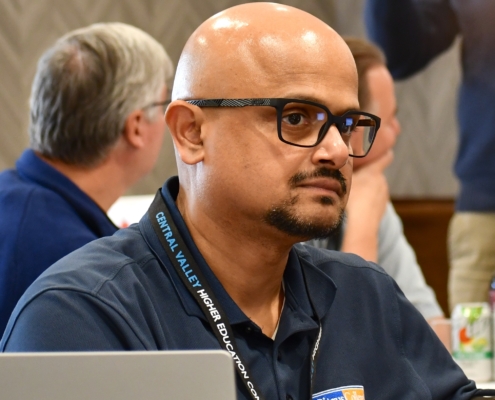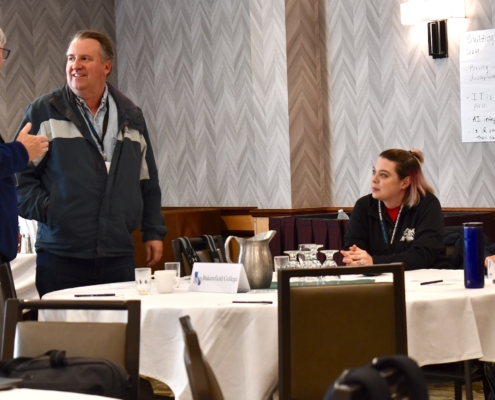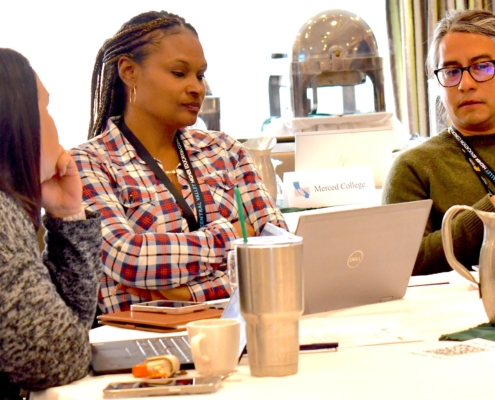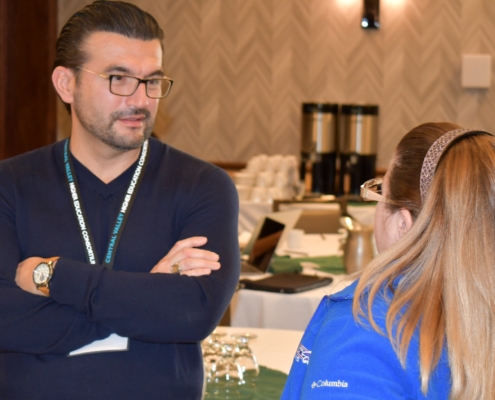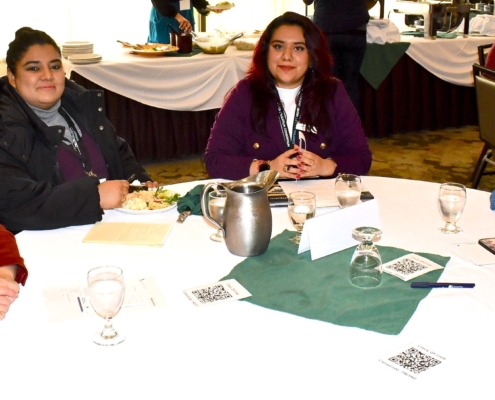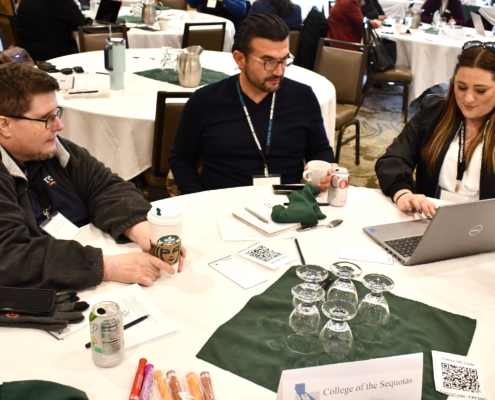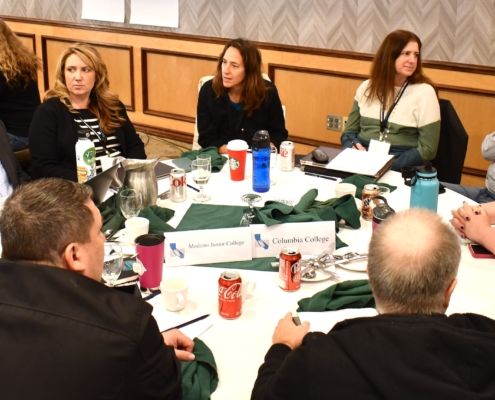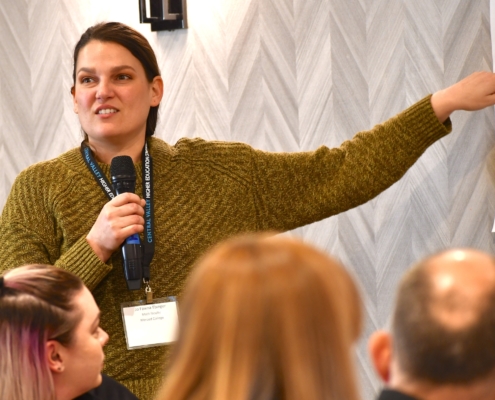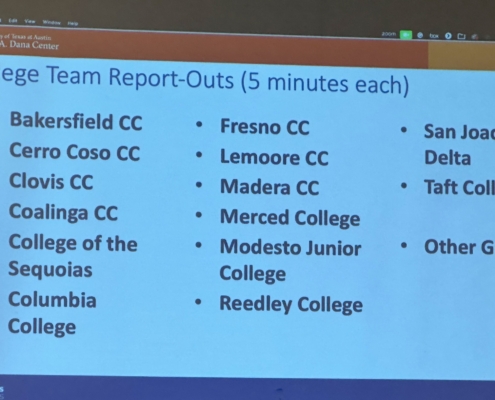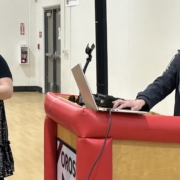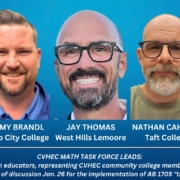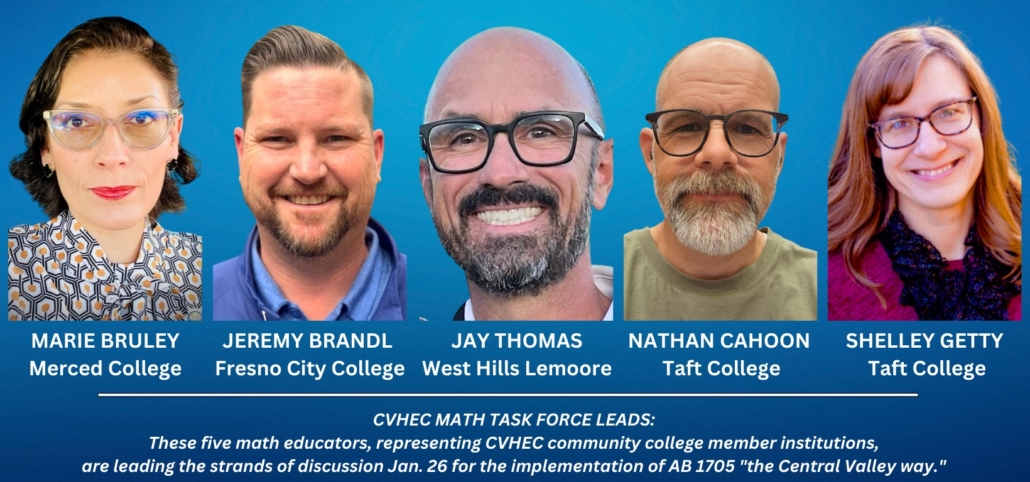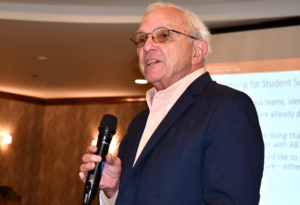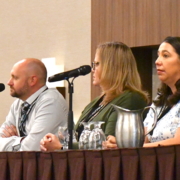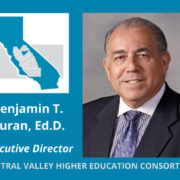Math Task Force continues AB 1705 work with April 19 convening
Secondary education voices invited to join discussion
Discussions to improve calculus pathways for STEM students amidst a pending deadline this summer continues with the third “Central Valley Way to AB1705 Success” Convening set for Friday, April 19 in Fresno that will also bring more secondary education voices to the table and a review of guidance issued by the California Community College Chancellors Office last month.
Registration is now open for the event in Fresno presented by the Central Valley Higher Education Consortium Math Task Force with the Charles A. Dana Center (University of Texas at Austin) from 9 a.m. to 3 p.m. at the DoubleTree by Hilton Hotel Fresno Convention Center, the site of two previous in-person convenings last fall and in January.
The event will re-convene community college math educators, administrators and institutional researchers working since the fall towards compliance with the final stage of AB1705: validation of equitable placement, support and completion practices for STEM programs.
Signed into law by Gov. Newsom in September 2022, AB 1705 is an amendment to the landmark legislation AB 705 (Irwin, 2017) which transformed placement and developmental education in the California Community Colleges. AB1705 supports full and comprehensive implementation by, among other requirements, specifying that colleges must demonstrate the benefit of transfer-level math preparatory courses for STEM Calculus 1 based on the following conditions:
- The student is highly unlikely to succeed in the first STEM calculus course without the additional transfer-level preparation.
- The enrollment will improve the student’s probability of completing the first STEM calculus course.
- The enrollment will improve the student’s persistence to and completion of the second calculus course in the STEM program, if a second calculus course is required.
From now until July 1, colleges have the opportunity to validate that their preparatory courses meet the aforementioned AB 1705 standards.
Since passage, the state’s community colleges have worked towards compliance of various aspects of AB1705 including 19 Central Valley community college members of CVHEC through representatives serving on the consortium’s Math Task Force consisting of math faculty and administrators.
The task force has held several virtual and in-person work sessions since October designed to collaborate in unity for compliance. At the last convening Jan. 26, more than 82 math and administrative representatives from the community colleges — including several campus research professionals — and one high school principal met with the task force to explore five strands of curriculum planning:
- Validating Prerequisites;
- Designing Precalculus for 2025;
- Math Support Outside and Inside the Classroom;
- Building an AB 1705 Campus Team; and
- Guided Self-Placement.
Since the Jan. 26 meeting, the strand leads have been preparing summaries of their breakout discussions held that day, said Dr. John Spevak, CVHEC regional coordinator who oversees the consortium’s Math Task Force.
Member college teams are also preparing summaries of the tentative plans they developed in the afternoon breakout sessions for oral reports. Additionally, the workgroups have been meeting and will report out on their progress in April regarding the strands.
A good portion of the April 19 meeting will be devoted to the data collection underway by CVHEC community college research professionals related to student success in math, part of the valleywide Data Collection Project under development by the consortium, said Spevak, who will again co-facilitate the April event with Dana Center colleague Dr. Tammi Perez-Rice.
Secondary ed voices
This next convening will also include representatives of K-12 school districts, including several high school principals who have already worked with CVHEC through the Central Valley Math Bridge Program.
“It’s important to bring into the conversation high school leaders and our colleagues who care as much about the future math success of students as community college math educators do,” said Dr. Benjamín Durán, CVHEC executive director.
That conversation was begun at the January convening of community college math professors and administrators when Marlena Celaya, principal of Orosi High School and former high school math teacher, told the group that Central Valley high school educators would very much like to participate in future discussions about math success for Central Valley students.
Spevak said this development will also foster additional learning about the high school math landscape as it pertains to college readiness.
Any Central Valley secondary education officials interested in attending the April 19 convening are welcome, he added.
CCC ‘validation memo’
Also up for discussion will be a Feb. 27 validation memorandum by the California Community College Chancellors Office entitled AB 1705 Validation of Equitable Placement, Support and Completion Practices for STEM Programs.
The Chancellor’s Office also presented a webinar March 4 to further discuss the details of this guidance and address questions.
The Dana Center and CVHEC teams are presently reviewing the CCC memo to provide analysis that will help guide the Math Task Force’s five strands committees and will be presenting its memo assessment in the coming weeks, said Joan Zoellner, M.A., who is the lead for the Dana Center’s Launch Years Initiative;
In a preliminary review of the memo, Zoellner noted that while the CCC memo provides direction on the validation process for transfer level math placement and enrollment practices for STEM programs, it indicates that no more than one transfer-level prerequisite shall be offered prior to calculus.
“The options for that prerequisite course are limited by the memo and validation options as well,” Zoellner said.
She recommended that consortium community colleges review the chancellor’s office memo and some of the findings presented to determine how it affects their respective campus.
“If possible, work with your IR department to confirm those numbers and results prior to the April 19 convening,” Zoellner advises.
For more info: centralvalleyhec@gmail.com
For media inquiries: Tom Uribes – cvheccommunications@mail.fresnostate.edu (or text 559.348.3278).
See also:
- CCCCO Memo Feb. 27, 2024: AB 1705 Validation of Equitable Placement, Support and Completion Practices for STEM Programs
- CVHEC Math Task Force
- What is AB 705 and AB 1705?
- WHAT THE CV-HEC IS HAPPENING BLOG (October 2022): AB 1705 – What Does It Do?
- CCC Memos and Resources
- https://bit.ly/MTFconveneKSEE24
- Valley’s math ed experts unite to address AB 1705 challenge for student success
- The CVHEC Way to Math Success — Implementing AB1705
- Math Task Force begins discussion of AB1705 implementation – Nov. 17 next
CVHEC Math Task Force meets in-person Oct. 13 for AB 1705 follow-up - NEWS RELEASE – CVHEC Math Task Force: Impactful legislation (AB 1705) Convenings Oct. 6 & 13
- CVHEC Website Feature: Math Task Force Page
MATH TASK FORCE: ‘Something extraordinary’ (Jan. 26 wrap)
Modesto Junior College math professor Tina Akers-Porter discusses her strand group’s deliberations at “The Central Valley Way to AB1705 Success” Convening Jan. 26 where a call for a “principals task force” by Orosi High School Principal Marlena Celaya would bring more secondary education voices to the table.
‘Something extraordinary is happening in math in California’s Central Valley’
Math Task Force latest AB1705 session leads to calls
for more data, high school input, re-convene April 19
BY TOM URIBES
CVHEC Media/Communications Coordinator
Realizing that state guidance surrounding Assembly Bill 1705 remains elusive, valley community college math educators and officials forged ahead at “The Central Valley Way to AB1705 Success” convening Jan. 26 in Fresno with a determined and unified mindset to develop implementation plans that will serve the best interests of their students including a follow-up session set for April.
In addition, the Central Valley Higher Education Consortium (CVHEC) Math Task Force discussion centered around five strands of curriculum planning for implementation before the law goes into effect July 1, two aspects emerged at the lively day-long work session: the increased participation of institutional researchers for pertinent data-collecting and a call for a “principal’s task force” to bring upper secondary education voices to the table.
Presented by CVHEC, the convening — the latest in a series of deliberations since fall — was attended by 82 representatives from the consortium’s 19-member community colleges, one high school principal and campus research professionals.
They agreed to reconvene April 19 for reports on follow-up work that will occur as a result of this most recent event. Registration for that event will open next month with additional details forthcoming.
Facilitated by the Charles A. Dana Center at the University of Texas at Austin, the session last month reviewed five strands of curriculum planning: Validating Prerequisites; Designing Precalculus for 2025; Math Support Outside and Inside the Classroom; Building an AB 1705 Campus Team; and Guided Self-Placement.
“With tensions high and little guidance surrounding AB1705, the 19 community colleges and districts that comprise the CVHEC nine-county region are rolling up their sleeves and getting to work on this math movement the ‘Central Valley Way’,” summarized Tammi Perez-Rice of the Dana Center.
Perez-Rice, who co-facilitated the event, said the convening was solely dedicated to working and planning at a regional and institutional level in two parts. The first part was dedicated to expanding the five work groups that emerged from the Nov. 17 webinar and creating a plan to move forward. The second half of the convening was devoted to institutional planning.
“The fruits produced from these convenings are already being felt around the region,” Perez-Rice said. “The plans and implementations emerging from these convenings are more than just a response to AB705 and AB1705; they cultivate systemic reforms that will benefit all students in the CVHEC region and beyond.”
John Spevak, CVHEC regional coordinator who oversees the consortium’s Math Task Force and co-facilitator of the Jan. 26 gathering, said in the short-term, the five strands work groups will continue to communicate and provide updates in preparation for the April 19 convening. The strand leads are preparing summaries of their Jan. 26 breakout discussions and member college teams are preparing summaries of the tentative plans they developed in the afternoon breakout sessions for oral reports in April.
“In the longer term, our Math Task Force will continue to monitor what the California Community College Chancellor’s Office says, while mainly going forward with our own Central Valley approach to the five strands.”
That “Central Valley Way” stems from the work undertaken by the CVHEC Math task Force, first formed in 2019, in the past year that was intensified with four work sessions beginning Oct. 6 in a virtual convening with CCC vice-chancellor Eric Cooper. The first in-person session followed Oct. 13 in Fresno and another virtual session was held in two parts Nov. 17 before the Jan. 26 session.
These sessions may represent the only concerted effort by a region’s community college math community actively meeting to collaborate across campus boundaries for ways to unite as one voice and determine a curriculum course of action that meets the law’s intent, Spevak said.
“We at CVHEC, along with the Dana Center representatives and our College Bridge partners in the Math Bridge Program, feel that something extraordinary is happening in math in the Central Valley of California,” Spevak said.
After the Jan. 26 session ended, Perez-Rice reiterated a point she made the first time she visited Fresno for the first in-person convening last fall:
“This collaboration today was amazing. As I travel and talk to math faculty all over the country, what I see pulsating from the CVHEC community here in Central California is just compassion; caring about their students; putting their students first; understanding what their students need; and more importantly collaborating with each other working across institutions to make things happen.”
Inviting secondary ed voices to ‘align syllabi’
A key development of the convening was the assertion and agreement that a crucial next step is “to involve high schools in the discussion and determine how to breakdown barriers between systems for a cohesive collaborative effort to put students first across the state of California,” a message delivered by Marlena Celaya, principal of Orosi High School who was the only secondary education official in attendance.
Celaya’s comments, first in a strand session and later in general comments before the assembled group, resonated with the community college professionals as she offered to lead a task force of principals/administrators who would unify with the CVHEC community college math educators for implementation strategy — to listen and hear what the needs are and how to meet those needs.
“I’m willing to lead this work because I don’t want people to go through the wars I went through teaching algebra and volunteering all my time,” said Celaya, a former math teacher at Dinuba High School. “We would want to hear from community colleges and say to them ‘what do you need?’
“We heard something from you today: ‘I want to know what courses are offered at the high school and what does that course description look like?’ Aligning syllabi is what I’d like to do,” Celaya said. “Mathematics is my passion.”
Perez-Rice said the April 19 convening promises more high school representation, with over twelve principals who are part of the Math Bridge Program by CVHEC and College Bridge being invited. Other secondary education officials from throughout the valley are welcome she said.
Participant feedback: ‘great to see we’re not alone in this …’
After the event, several participants shared their assessment of the Jan. 26 convening.
“The conversations were amazing and we really appreciated being here,” said Joshua Lewis, chair of the Bakersfield College Mathematics Dept.
“There have been so many legislative changes and so many unknowns it’s nice to see the work that other campuses are doing and realize that we’re not alone, that we have shared values; that we have shared emphasis on student learning and really care about doing right by all of our students,” he added.
Nathan Cahoon, Taft college math professor, felt that the efforts of CVHEC’s Math Task Force as exhibited at the convening is strengthening the voice of the valley’s math community which will have an impact.
“It was amazing to work with incredible professionals who have some really amazing ideas,” he said. “I know I took many good notes about ideas to implement at our college. The connections we are building here with each other will be powerful down the road as we build a cohesive effort to get some good research together that we can send to the state as one voice from all the colleges.”
Modesto Junior College math professor Marina Hernandez said coming together within the region is relished because when attending other statewide or national conferences, the focus is not as localized.
“It was very helpful to learn what other colleges in the Central Valley are doing because we share similar student population and resources characteristics and their best practices are applicable to us here in our region,” Hernandez said.
Tina Akers-Porter, Modesto Junior College math professor, said the Math Task Force work has helped her better understand what AB1705 is and what it means for her students.
“I feel like I have a better understanding of some of the challenges of the legislation and what others are worried about,” she said. “We share some of those worries but it’s great to hear different points of view on that. A byproduct of this is we are seeing how we need to support underprepared students more, inside and outside the classroom, and sharing ideas to do that.”
Shelly Getty, Taft college math faculty and a strand leader, echoed Akers-Porter: “We left knowing we are going to start some specific tutoring and targeting students for tutoring. We will try to advertise it better and recruit so students get more access to the services we already provide which will greatly impact them. We shared some good ideas on how to do that effectively.”
Marissa Martinez, Taft college math professor, said, “We have our work cut out for us. There’s a lot of things that we have to address with a lot of moving parts. Everything keeps changing but it was great to be able to see that we’re not alone in this, that we’re working together to better serve our students.”
She said this intercollegial collaboration and the feedback from the colleges helps “so we don’t have to reinvent the wheel — what worked, what didn’t work.”
Next steps? Data research
“I would say the next step is collecting our data to see how the numbers show where we are so we can prove that these courses are important for our student success,” Martinez said.
This data aspect was also a key part of the convening as institutional research professionals were invited and directly participated such as Arooj Rizvi, research analyst in the Office of Institutional research and Effectiveness at San Joaquin Delta College.
“Researchers have a monumental role in the implementation of AB 1705 because policymakers are going to depend a lot on what we are able to produce as a group or even as an institution,” Rizvi said. “Being a part of these conversations helps us to see the bigger picture, the context and the requirements of what exactly it is that we are looking for in the data.”
She said it was exciting to hear at the convening what area colleges are going through.
“I realized how similar our challenges are from institution to institution, “she said. “Working through that together and being solution-oriented is something that’s going to take all of us towards a beneficial direction. Seeing us all here today was a defining moment in history.”
Owynn Lancaster, vice president of academic strategy for CVHEC partner College Bridge, said the event was “a huge success seeing folks come together from math to talk about math and really pool their resources to address actual challenges.
“The most powerful focus of change in education is always the educator,” Lancaster said. “I know everything’s heaped on them but in a lot of ways they have the greatest power of the greatest agency for this.”
For more info: centralvalleyhec@gmail.com
For CVHEC media inquiries: Tom Uribes – cvheccommunications@mail.fresnostate.edu (or text 559.348.3278).
See also:
https://bit.ly/MTFconveneKSEE24
Valley’s math ed experts unite to address AB 1705 challenge for student success
The CVHEC Way to Math Success — Implementing AB1705
Math Task Force begins discussion of AB1705 implementation – Nov. 17 next
CVHEC Math Task Force meets in-person Oct. 13 for AB 1705 follow-up
NEWS RELEASE – CVHEC Math Task Force: Impactful legislation (AB 1705) Convenings Oct. 6 & 13
CVHEC Website Feature: Math Task Force Page
PHOTO GALLERY
Valley’s math ed experts unite to address AB 1705 challenge for student success
Math Task Force Convening Jan. 26:
‘Central Valley Way To AB1705 Success’
With the agenda released this week, over 60 Central Valley math education experts will convene in Fresno Jan. 26 to plan math pathways for student success as they brainstorm within five strands of implementation around Assembly Bill 1705 that goes into effect this summer.
The Central Valley Higher Education Consortium’s “Central Valley Way To AB1705 Success” Convening from 9 a.m. – 3 p.m. at the DoubleTree by Hilton Hotel Fresno Convention Center, will bring together community college math educators, administrators and institutional researchers.
Presented by the CVHEC Math Task Force and facilitated by the Charles A. Dana Center at the University of Texas at Austin, the convening is free with advance registration and includes lunch.
Discussion for the historic convening — with administrators and IR experts joining in the conversation — will center around five strands that the region’s community college math academicians can undertake for student success when the new law goes into effect July 1: Validating Prerequisites; Designing Precalculus for 2025; Math Support Outside and Inside the Classroom; Building an AB 1705 Campus Team; and Guided Self-Placement.
Five Math Task Force members serving as strand leads are: Jeremy Brandl, Fresno City College math professor; Nathan Cahoon and Shelley Getty, both Taft College math professors; Marie Bruley, Merced College dean of Science, Technology, Engineering, and Math (STEM); and Jay Thomas, West Hills College Lemoore math professor.
After the event opens with a welcome and brief introductions, the strand subcommittees open the discussion by presenting reports regarding preliminary strand deliberations over the past few months that started at three meetings the Math Task Force held in the fall.
Participants will then break into tabletop talks for feedback and to brainstorm new ideas, a timeline and next steps followed by report outs of those subcommittee sessions.
Following lunch, the participants will break into their respective college teams to discuss “Preliminary College Plans” in two parts: “Validating Prerequisites Between Now and July 1, 2024;” and “Developing New/Revised Curriculum to Take Effect July 1, 2025.”
“College Team Report Outs” will follow before the final session “Where Do We Go From Here?” looks towards the future and the role of Math Task Force sub-committees, college teams and CVHEC.
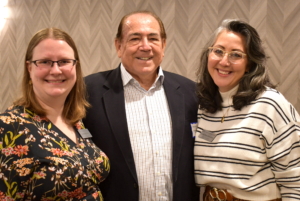
Dr. Benjamín Durán of CVHEC with Dana Center reps Joan Zoellner and Tammi Perez-Rice at the Oct. 13 Math Task Force convening in Fresno.
Dr. Benjamín Durán, CVHEC executive director, said, “We are proud that our Central Valley community colleges are leaning in on the expertise of their own math experts to figure out the best way to support our students within the guidelines of the legislation.”
AB 1705 — passed in 2022 for implementation July 1, 2024 — expands the provisions established in AB 705 (2017) by explicitly requiring community colleges not only to place students directly into transfer-level English and math courses but also to ensure that students actually enroll in those courses.
The legislation also establishes that for students who need or desire extra academic support, community colleges shall provide access to such support. The new law clarifies that a community college can require students to enroll in additional concurrent support if it is determined that the support will increase the student’s likelihood of passing transfer-level English or math.
Community colleges have been tasked with ensuring they comply with both AB705 and AB1705 designed to strengthen support for student success and increase degree completion.
CVHEC helped start the conversation by bringing together its Math Task Force — made up of representatives from CVHEC community colleges — and other math educators to discuss ideas and options regarding implementation within the Central Valley community college mathematics community last fall.
In three virtual sessions and one in-person convening in 2023, the Math Task Force created a collaborative “Central Valley Approach” to each, said Dr. John Spevak, CVHEC regional coordinator who oversees the consortium’s Math and English Task Forces.
“Now, for the January session, administrators and researchers are joining the Math Task Force to develop data-driven and college-endorsed solutions that help meet the challenge head on and in unity for the best interests of students.”
The fall inaugural sessions were facilitated by two Dana Center representatives who will return to Fresno for the Jan. 26 convening: Joan Zoellner, M.A., who is the lead for the Dana Center’s Launch Years Initiative; and Dr. Tammi Perez-Rice, Postsecondary Course Program specialist.
Dr. Erik Cooper, assistant vice chancellor of the California Community College Chancellor’s Office Cooper, also participated in the first virtual session to discuss the recent history of math education reform in California and answer questions as well as present the CCCCO’s AB 1705 Implementation Guide and FAQ webpage.
“With the passage of AB 705 then later 1705 – all designed to strengthen support for student success – CVHEC has been moving full steam ahead in assuring that our member colleges and their feeder high schools have a good understanding of the seemingly turbulent waters of the legislation,” Durán said.
Strand breakdown:
- Validating prerequisites — quantitative and qualitative: creating a Central Valley collaborative approach which would help make a strong case with the state. Point person: NATHAN CAHOON, Taft College math professor.
- Designing Precalculus for 2025: An effective single-course prerequisite for Calculus 1 (especially valuable if the state allows in 2025-26 only one prerequisite course for Calculus 1). Point person: JEREMY BRANDL, Fresno City College math professor.
- Math support outside and inside the classroom: What’s working best in the Central Valley, including math lab centers, tutoring, embedded tutoring, supplemental instruction, etc. Point person: SHELLEY GETTY, Taft College math professor.
- Building an AB 1705 campus team: Who needs to be on the team? Math and English professors, IR/IT staff, counselors, administrators, etc. How does it best function? Point person: MARIE BRULEY, Merced College dean of Science, Technology, Engineering, and Math (STEM).
- Guided self-placement: Helping ensure with the best possible questionnaire that students are taking the right math class when they start college. Point person: JAY THOMAS, West Hills College Lemoore math professor.
(Links to recordings of the two previous sessions are available below).
REGISTER – “The CVHEC Way to Math Success — Implementing AB1705” (Jan. 26, 2024)
EVENT AGENDA For questions: centralvalleyhec@gmail.com.
For media inquiries: Tom Uribes 559.348.3278 (text msg) or cvheccommunications@mail.fresnostate.edu
SEE:
- Previous sessions recordings:
CVHEC “AB1705 in the Central Valley” Webinar with Dr. Erik Cooper Oct. 6, 2023
MTF meeting Nov. 17 (10 a.m. session)
MTF meeting Nov. 17 (1 p.m. session)
- Coverage of the fall sessions:
Math Task Force begins discussion of AB1705 implementation – Nov. 17 next (with Oct. 13 photo gallery).
CVHEC Math Task Force meets in-person Oct. 13 for AB 1705 follow-up
NEWS RELEASE – CVHEC Math Task Force: Impactful legislation (AB 1705) Convenings Oct. 6 & 13
- The CCCCO’s AB 1705 Implementation Guideand FAQ webpage.
- The CVHEC Math Task Force
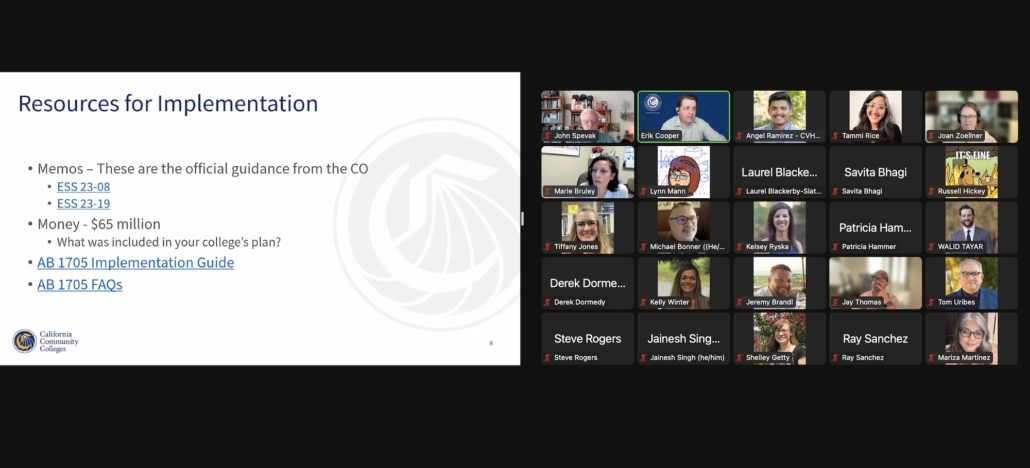
Dr. Erik Cooper of the California Community Colleges Chancellor’s Office zoomed into the Oct. 6 CVHEC Math Task Force session to address AB1705 implementation.
CVHEC to lead California delegation at CCA Day on the Hill May 16- 17
Dr. Benjamin Duran, executive director of the Central Valley Higher Education Consortium, will join Complete College America for its CCA Day on the Hill in Washington, D.C. May 16- 17 where “a network of higher education experts share strategies and lessons for the implementation of higher ed strategies at scale.”
Complete College America, a national non-profit organization founded in 2009 to raise postsecondary attainment in the United States, is a national alliance of state and higher education leaders .
Alliance partners collaborate to introduce bold initiatives that help states and institutions confront inequities, close institutional performance gaps and increase college completion rates, especially for marginalized and historically excluded students.
At the CCA Day on the Hill event, Alliance members directly engage in the federal legislative process with their federal representatives and share best practices in states and regions that can be translated into federal policy while advancing CCA’s legislative agenda at the federal level, said Charles Ansell, CCA vice president for Research.
“As Congress looks to reauthorize the Higher Education Act next year, CCA Alliance members who participate in this opportunity will bolster the organizations’ efforts to make a lasting federal policy impact to support students seeking to complete college,” Ansell said.
The event starts on Tuesday, May 16 when Alliance members will attend an in-person training for the Day on the Hill with CCA’s federal lobbyists, Arnold & Porter (A&P). A&P will set up all member meetings while in DC and will provide a schedule for their Hill visits, which will take place between 8 a.m. to 5 p.m. on Wednesday, May 17.
Dr. Duran is the Alliance lead for California’s central region, serving as the go-to resource as members work to advance student success.
Dr. Brandon Protas, assistant vice president for Alliance Engagement, said CCA recognizes CVHEC — made up of 28 institutions of higher education in the Central California’s nine-county region with the presidents and chancellors of each member institution serving on its board of directors — as the convener and facilitator of education, community and legislative representatives as well as technical support experts as needed by members in carrying out the CVHEC board’s key policy objective: to increase the Central Valley’s degree attainment.
The consortium works with legislative leaders as an advocate of the higher education policy positions of its board, he noted, fortifying the Central Valley as an “educational powerhouse.”
“We are thrilled that Executive Director Durán is partnering with CCA leveraging his visionary leadership and commitment to equitable degree attainment to influence federal policy that ensures higher education accessibility for all,” Dr. Protas said.
“This strategic collaboration not only strengthens the Central Valley community but empowers its diverse student population to see policy work that helps them to achieve their fullest potential, thereby promoting the Central Valley as an educational powerhouse for generations to come.”
Duran said the CCA, which CVHEC joined in 2016, shares many of the consortium objectives.
“CCA is a valuable partner because it provides a network of higher education experts who share strategies and lessons for the implementation of higher ed strategies at scale,” Duran said. “The CCA alliance advocated for work in corequisite support and math pathways projects, working with multiple states to create the conditions for change required to implement the strategies at scale.”
For more information, visit www.completecollege.org.
CVHEC Director’s Message (July 2022): Summer ‘recharge’ and a renewed appreciation
Greetings and welcome to our July CVHEC e-newsletter,
This month we share a brief issue and greeting as we find ourselves in the first summer since 2020 where the pandemic is not ruling our lives.
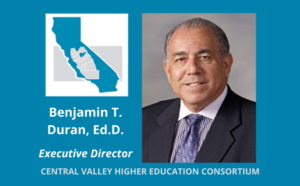 I hope you all enjoyed fabulous live commencement exercises on your campuses. We know students, family, professors, and staff have been looking forward coming together again to celebrate the accomplishments of our students in the Central Valley.
I hope you all enjoyed fabulous live commencement exercises on your campuses. We know students, family, professors, and staff have been looking forward coming together again to celebrate the accomplishments of our students in the Central Valley.
I’m sure many of you agree that one take-away from the pandemic experience – with life seemingly coming to halt the past two years amid shutdowns and event cancellations – is the renewed appreciation we find in everyday routines like pulling into the campus parking lot, crossing the beautiful landscapes of our 30 campuses across the valley, walking into classrooms and seeing those eager faces, reconvening with colleagues in the office and most significantly, sitting in an arena, stadium or any venue to bask in the joy of our students walking across the stage to receive their diploma, a celebration with their friends and families of the hard work and success by all in academia.
This summer we will continue to work on our regional initiatives like dual enrollment, creating a Central Valley transfer model and working on developing math pathways between our K12 partners and our CVHEC member institutions.
Until we usher in the fall 2022 semester together, I hope you will find some time to rest, recharge, enjoy time with your loved ones and maybe even a do little travel once again. We look forward to regrouping in August and kicking-off another impactful year.
Have a great summer!!!
CVHEC Member News: CLP Guidance Pathways
Four CVHEC Members Highlighted in Career Ladders Project
Look at Guided Pathways Redesign Challenges
The Career Ladders Project recently highlighted four CVHEC member organizations in stories illustrating how 15 California community colleges are redesigning their Guided Pathways programs and structures prompting college leaders across the state to share the stories to help clarify opportunities, spur conversation and motivate Guided Pathways redesign teams.
Founded by the California Community Colleges Board of Governors in 2002, Career Ladders Project is a nonprofit that operates under the fiscal sponsorship of the Foundation for California Community Colleges.
The project promotes equity-minded community college redesign by collaborating with colleges and their partners to discover, develop, and disseminate effective practices. CLP policy work, research, and direct efforts with colleges lead to system change—and enable more students to attain certificates, degrees, transfers, and career advancement.
The Guided Pathways stories are presented in one-page narratives — grouped into topics — produced by Career Ladders Project with funding from the California Community Colleges Chancellor’s Office.
The four CVHEC members highlighted are:
Bakersfield College
• Integrating Student Supports in Guided Pathways Redesign
• Aligning Redesign Across Campus
• Using Data in Guided Pathways Redesign
Madera Community College
• Centering Students in GP Design
West Hills College Lemoore
• Aligning Redesign Across Campus
• Supporting Students from a Distance
Reedley College
Managing Guided Pathways redesign and Engaging the College
See the CLP Redesign stories overview.

